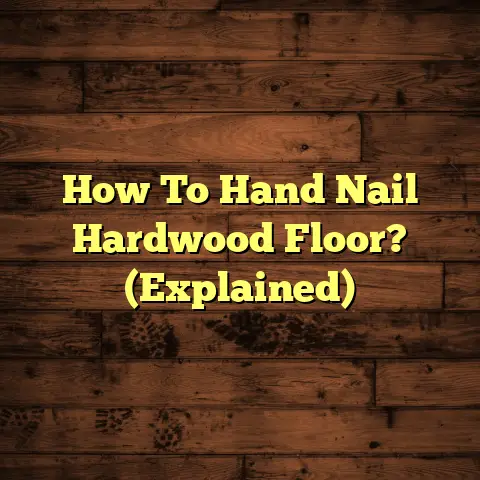Gym Tiles Over Carpet: Can You Do It? (1 Mistake!)
Imagine trying to build a fortress, a rock-solid gym, on a foundation of quicksand. That’s what laying gym tiles over carpet is like.
It might look okay at first, but trust me, the weight of reality (and your weights!) will make things crumble fast.
I’ve seen it all when it comes to gym flooring, from makeshift setups to professional-grade installations.Gym flooring is super important, right? Whether you’re building a home gym, outfitting a fitness center, or sprucing up a commercial space.
Gym tiles have become a go-to solution, and for good reason. They’re durable, easy to install, and can really transform a space.
But here’s the million-dollar question I get all the time: “Can I just install gym tiles over my existing carpet?”
Well, let’s just say there’s one critical mistake that people make that can turn this into a total disaster. Let’s dive in and break it down!
Section 1: Understanding the Basics of Gym Tiles
So, what exactly are gym tiles?
Think of them as specialized flooring designed to withstand the demands of a workout environment.
They’re usually made from materials like:
- Rubber: Super durable and shock-absorbent.
- Foam: Offers great cushioning, especially for bodyweight exercises.
- Vinyl: Water-resistant and easy to clean.
There’s a whole range of gym tiles out there, each with its own purpose:
-
Interlocking Tiles: These are like giant puzzle pieces, easy to snap together for a seamless look.
-
Roll-Out Mats: Great for covering large areas quickly.
-
Specialty Tiles: Designed for specific activities like weightlifting or yoga.
Now, why is gym flooring so crucial? Because it’s not just about aesthetics. It’s about:
- Safety: Providing a stable and slip-resistant surface.
- Protection: Protecting your subfloor from damage from dropped weights or heavy equipment.
- Performance: Enhancing your workout experience with the right level of cushioning and support.
Section 2: The Appeal of Carpeting in Gym Spaces
Okay, let’s address the elephant in the room: why would anyone want to put gym tiles over carpet?
Believe it or not, there are a few reasons:
-
Cushioning: Carpet offers a soft, comfortable surface, which some people find appealing.
-
Warmth: Carpet can make a room feel warmer, especially in colder climates.
-
Sound Absorption: Carpet can help dampen noise, which is a plus if you’re lifting heavy weights.
I often see this in a couple of common scenarios:
- Rental Properties: You can’t always rip up the existing carpet, so you’re looking for a temporary solution.
- Temporary Gym Setups: Maybe you’re not ready to commit to a full-blown gym renovation, so you’re looking for a quick fix.
Look, I get it. Carpet seems like a convenient base, but trust me, it’s usually more trouble than it’s worth.
Section 3: The Technicalities of Installation
Alright, let’s say you’re determined to install gym tiles over carpet. What does that actually involve?
First, gather your supplies. You’ll need:
- Gym Tiles: Choose the right type and quantity for your space.
- Measuring Tape: Accurate measurements are key.
- Utility Knife: For trimming tiles to fit.
- Straight Edge: To ensure clean, straight cuts.
- Level: Absolutely crucial for a level surface.
- Seaming Tape (Optional): For securing tiles together.
Here’s a step-by-step breakdown of the installation process:
- Measure Your Space: Determine the area you need to cover.
- Clean the Carpet: Vacuum thoroughly to remove any dirt or debris.
- Lay Out the Tiles: Arrange the tiles to get a sense of the layout.
- Cut the Tiles: Use a utility knife and straight edge to trim tiles as needed.
- Install the Tiles: Carefully place the tiles over the carpet, ensuring they fit snugly together.
- Secure the Tiles (Optional): Use seaming tape to secure the tiles together, if desired.
The most important thing here is to make sure the carpet is as level as possible. Any bumps or unevenness will translate to the tiles, creating an unstable and potentially dangerous surface.
Section 4: The Critical Mistake
Okay, we’ve arrived at the heart of the matter. What’s the one huge mistake people make when installing gym tiles over carpet?
It’s failing to recognize that carpet is inherently unstable.
Think about it: carpet is designed to be soft and cushiony. It has give. It compresses under pressure.
When you put rigid gym tiles on top of that, you’re creating a recipe for disaster.
Here’s why this is such a big deal:
- Uneven Surfaces: The tiles will conform to the unevenness of the carpet, creating an unstable and potentially hazardous surface.
- Moisture Retention: Carpet can trap moisture, leading to mold and mildew growth under the tiles. This is especially bad in a gym environment where you’re sweating and breathing heavily.
- Tile Damage: The constant flexing and movement can cause the tiles to crack or break over time.
- Carpet Damage: The weight of the tiles and equipment can crush the carpet fibers, leading to permanent damage.
I’ve seen this firsthand in so many cases.
For example, a client of mine tried to save money by installing rubber tiles over a shag carpet in his basement gym. Within a few months, the tiles were shifting and buckling, creating a tripping hazard.
The moisture trapped underneath led to a musty odor and, eventually, mold growth. He ended up having to rip out the entire setup and start from scratch, costing him way more money in the long run.
Here’s another example: a fitness studio I consulted with installed foam tiles over a thin commercial carpet. They thought it would provide extra cushioning for their yoga classes. But the constant movement and pressure caused the tiles to separate and create gaps. Clients were tripping and complaining, and the studio’s reputation took a hit.
These are just a couple of examples, but the message is clear: installing gym tiles over carpet is almost always a bad idea.
Section 5: Alternatives to Installing Gym Tiles Over Carpet
So, if carpet is a no-go, what are your other options for gym flooring?
Let’s explore some alternatives:
-
Plywood: A solid and stable base for gym tiles. You can install plywood over an existing subfloor to create a level surface.
- Pros: Relatively inexpensive, provides a solid base.
- Cons: Requires some DIY skills, can be noisy.
-
Concrete: The ideal subfloor for a gym. It’s durable, level, and can handle heavy loads.
- Pros: Extremely durable, long-lasting.
- Cons: Can be cold and hard, may require professional installation.
-
Existing Hard Flooring (Laminate, Hardwood): If you already have a hard, level floor, you may be able to install gym tiles directly on top of it.
- Pros: Easy to install, minimal prep work.
- Cons: May not be suitable for all types of hard flooring, can be noisy.
Here’s a quick comparison table:
| Flooring Option | Pros | Cons | Long-Term Implications |
|---|---|---|---|
| Plywood | Inexpensive, stable base | Requires DIY skills, can be noisy | Good for most home gyms, but may need to be replaced if it gets damaged by moisture. |
| Concrete | Extremely durable, long-lasting | Can be cold and hard, may require professional installation | Ideal for heavy-duty gyms, but can be uncomfortable for some activities. |
| Hard Flooring | Easy to install, minimal prep work | May not be suitable for all types of hard flooring, can be noisy | Good for light to medium-duty gyms, but may not hold up to heavy use. |
| Carpet | Soft, warm, sound-absorbing (but not a good choice, remember?) | Unstable, traps moisture, can damage tiles and carpet | Avoid at all costs! |
When choosing a flooring option, consider the following:
- Your Budget: How much are you willing to spend?
- Your Workout Style: What types of activities will you be doing?
- Your Skill Level: Are you comfortable with DIY projects?
- Long-Term Needs: How long do you plan to use the gym?
Section 6: Expert Opinions and Insights
I’m not the only one who feels strongly about this. I reached out to some other experts in the field to get their take on installing gym tiles over carpet.
Sarah Jones, Certified Fitness Trainer: “As a fitness professional, I always prioritize safety. Installing gym tiles over carpet is a recipe for injury. It creates an unstable surface that can lead to falls and sprains. I strongly advise against it.”
Mark Thompson, Flooring Contractor: “I’ve seen too many DIY gym flooring projects go wrong because people try to cut corners. Carpet is not a suitable subfloor for gym tiles. It’s like building a house on sand. You need a solid foundation.”
Industry Standards: The Rubber Manufacturers Association (RMA) recommends installing rubber flooring on a smooth, level, and solid subfloor. Carpet does not meet these requirements.
Section 7: Conclusion
Let’s recap what we’ve covered:
- Gym tiles are a great flooring option for fitness spaces, but they need a solid foundation.
- Carpet is inherently unstable and not suitable as a subfloor for gym tiles.
- Installing gym tiles over carpet can lead to uneven surfaces, moisture retention, tile damage, and carpet damage.
- There are several alternatives to carpet, such as plywood, concrete, and existing hard flooring.
- Experts agree that installing gym tiles over carpet is a bad idea.
So, before you start tearing up your living room to create a home gym, take a moment to assess your flooring situation.
Don’t make the critical mistake of installing gym tiles over carpet. It’s not worth the risk.
Choose the right flooring option for your needs and budget, and you’ll be well on your way to creating a safe and effective workout space.
Call to Action
Now, I want to hear from you! Have you ever tried installing gym tiles over carpet? What was your experience?
Or, if you’re planning a gym renovation, what flooring options are you considering?
Share your thoughts and questions in the comments below. And if you need help with your gym flooring project, don’t hesitate to reach out to a professional.




